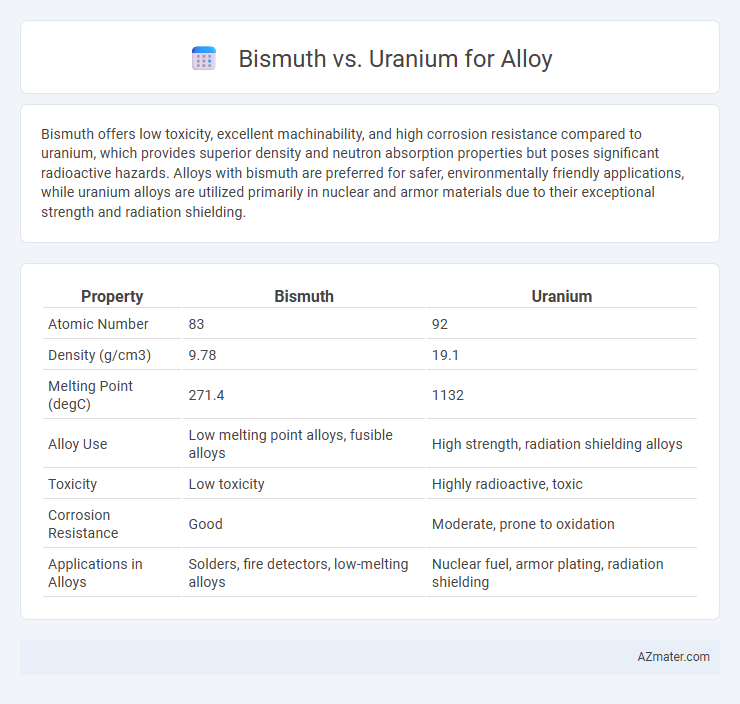Bismuth offers low toxicity, excellent machinability, and high corrosion resistance compared to uranium, which provides superior density and neutron absorption properties but poses significant radioactive hazards. Alloys with bismuth are preferred for safer, environmentally friendly applications, while uranium alloys are utilized primarily in nuclear and armor materials due to their exceptional strength and radiation shielding.
Table of Comparison
| Property | Bismuth | Uranium |
|---|---|---|
| Atomic Number | 83 | 92 |
| Density (g/cm3) | 9.78 | 19.1 |
| Melting Point (degC) | 271.4 | 1132 |
| Alloy Use | Low melting point alloys, fusible alloys | High strength, radiation shielding alloys |
| Toxicity | Low toxicity | Highly radioactive, toxic |
| Corrosion Resistance | Good | Moderate, prone to oxidation |
| Applications in Alloys | Solders, fire detectors, low-melting alloys | Nuclear fuel, armor plating, radiation shielding |
Introduction to Bismuth and Uranium Alloys
Bismuth alloys are prized for their low toxicity, high density, and excellent machinability, making them ideal for medical, safety, and recycling applications. Uranium alloys, especially those combined with metals like molybdenum or titanium, offer exceptional strength and density, primarily utilized in military and nuclear industries for armor and reactor components. The contrasting properties of bismuth and uranium alloys highlight their distinct roles in industrial and technological advancements.
Atomic Structure and Physical Properties
Bismuth features a rhombohedral crystal structure with a low atomic number of 83, contributing to its high density of 9.78 g/cm3 and a melting point of 271.5degC, making it ideal for low-melting alloys. Uranium, with an atomic number of 92 and an orthorhombic crystal structure at room temperature, exhibits higher density at 19.1 g/cm3 and a melting point of 1132degC, imparting superior strength and durability in alloys. The significant difference in atomic weight and crystal lattice affects thermal conductivity and malleability, with Bismuth providing better machinability and uranium delivering enhanced structural performance for specific alloy applications.
Melting Points and Thermal Conductivity
Bismuth has a melting point of 271.5degC and low thermal conductivity around 7.97 W/m*K, making it suitable for alloys requiring low melting temperatures and thermal insulation. Uranium's melting point is significantly higher at 1132degC, with thermal conductivity about 27 W/m*K, offering enhanced heat resistance and conduction in high-temperature alloy applications. The contrast in melting points and thermal conductivity between bismuth and uranium alloys determines their effectiveness in specific industrial uses, such as low-temperature soldering versus high-temperature reactor components.
Density and Weight Considerations
Bismuth has a density of approximately 9.78 g/cm3, significantly lower than uranium's density of about 19.1 g/cm3, which makes uranium alloys much heavier for the same volume. When weight is a critical factor, bismuth alloys offer advantages due to their lower density, enabling lighter and more manageable components. However, uranium's higher density provides superior radiation shielding and structural benefits in specific aerospace and defense applications.
Corrosion Resistance Comparison
Bismuth alloys exhibit superior corrosion resistance compared to uranium alloys, particularly in acidic and oxidizing environments, due to bismuth's inert nature and low reactivity. Uranium alloys, often prone to oxidation and corrosion when exposed to moisture and air, require protective coatings or inhibitors to maintain integrity over time. The enhanced corrosion resistance of bismuth-based alloys makes them preferable in applications where exposure to harsh chemical conditions is a critical concern.
Toxicity and Environmental Impact
Bismuth exhibits significantly lower toxicity and environmental impact compared to uranium, making it a safer choice for alloy applications. Unlike uranium, bismuth is non-radioactive and exhibits minimal bioaccumulation risks, reducing hazards during production and disposal. Uranium alloys pose serious radiological hazards and require stringent handling protocols due to their radioactive nature and potential environmental contamination.
Nuclear Properties and Applications
Bismuth exhibits low neutron absorption and excellent thermal stability, making it suitable as a coolant or component in nuclear reactors where neutron economy is critical. Uranium, particularly depleted uranium, has high density and fissile properties, enabling its use in nuclear fuel and radiation shielding applications. The contrasting neutron cross-sections and nuclear reactivity of bismuth and uranium dictate their distinct roles in advanced nuclear alloys and reactor design.
Industrial and Commercial Uses
Bismuth alloys are prized in industrial applications for their low toxicity, excellent machinability, and melting point suitable for precision casting, making them ideal in fire detection systems and medical devices. Uranium alloys, though less common due to radioactivity, are utilized in specialized commercial sectors like aerospace and military industries for their high density and strength. The contrasting properties define their niche uses, with bismuth favored in environmentally sensitive applications and uranium reserved for high-performance material demands.
Cost and Resource Availability
Bismuth alloys offer a cost-effective alternative with lower toxicity and greater resource abundance compared to uranium, which is expensive due to its radioactive properties and limited mining locations. Uranium's use in alloys is restricted by stringent regulations and high extraction costs, while bismuth is more widely available and easier to procure globally. The economic and supply advantages make bismuth alloys preferable for commercial applications where safety and affordability are critical.
Summary: Choosing Between Bismuth and Uranium for Alloys
Bismuth alloys offer non-toxicity, low melting points, and high density, making them ideal for safer, environmentally friendly applications and precision casting. Uranium alloys provide exceptional density and strength, useful in military and aerospace industries but pose significant health and regulatory risks due to radioactivity. Selecting between bismuth and uranium alloys depends on the balance between safety, environmental concerns, mechanical properties, and application-specific performance requirements.

Infographic: Bismuth vs Uranium for Alloy
 azmater.com
azmater.com